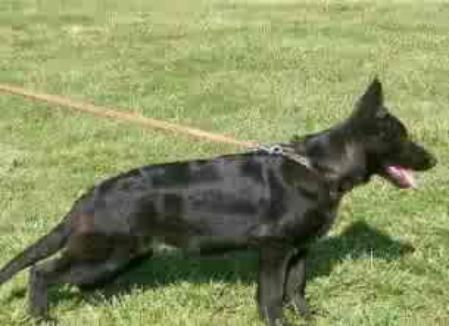
This is a placeholder text
Group text
by katjo74 on 01 March 2008 - 04:03
Malcolm Willis does not cover the exact subject matter here, which is "Are varying degrees of black GSDs still considered black?". He does say, like I said earlier, that a black GSD has to have the recessive gene for black inherited by both parents in order to produce it. There's no other way to get it-the parents either must be the color black OR be carriers of it.
So, if a black with the sabling mentioned is genetically tested and confirmed "bb", then it is a true black, even tho another color in adulthood is present.
If a black with the bi-color ticking between the toes is genetically tested and confirmed "bb", then the same can be said.
If the bi-color marked GSD is genetically tested and is confirmed "Bb" then it is a bi-color patterned dog, NOT a true black.
And the rest with all the other potential variations of black.
True-you get a TRUER solid black pigment in GSDs with blacks saturated in the pedigree. I've see more bleed-thru color in breedings where one parent is solid black and the other is a traditional blk/red, blk/tan or sable than from 2 black parents.
One female puppy I produced out of a solid black majority WGR show line w/some working line male and a traditional blk/red 100% WGR show line female was SOLID black until her 4th month. Then I noticed small iron-grey tufts came out underneath either armpit and a little along the sides of her neck. I was truly amazed at the change, but she was without a doubt black from birth, with a black nose and everything upon being freshly whelped. The pic isn't the best, but you can catch a faint glimpse of the grey tuft right behind her elbow.This is her at 5 mos old 2yrs ago.
by Laramie on 01 March 2008 - 04:03
Many so called "first generation" solid blacks will develop some shading on legs or between toes etc as they mature. Maybe even individual hairs on the tail. If the parents come from a genetically strong background for deep rich pigmentation in general, the darker the blacks will be. Each generation of black to black breeding will result in blacker progeny.
Jeenellyn Kennels and Maur-Ray Kennels were breeders of solid blacks exclusively. Maur Ray kept detailed and extensive records of all her breedings. Ellen Heintz, Jeenellyn Kennel, started with Maur Ray stock and I was priviledged to be one of her friends. A bitch I had from her was the inkiest black I have ever had. She was from generations of black to black breeding...
The way to tell a true solid black at birth is look under the tail.. If it is all black, with NO vent patch marking, like a bi-color, it is a true solid black. It could be all black BUT if it has the definate vent patch marking it is a bi-color, not solid black.
Malcolm Willis Book The German Shepherd Dog, It's History Development and Genetics, has excellent chapter on color. IF you can find the book.
by Two Moons on 01 March 2008 - 06:03
I have one black that is solid black yet she has light hairs between her toes. Another black that was solid at one year of age started changing and now shows faint light tan inside the legs and lightened up around the vent. I was told that the light vent made him Bi-color.
Laramie, if your who I think you are I have seen your dogs, I am familiar with Jeenelyn's site as well. Some handsome dogs. My male didnt show a light patch around the vent till a year and then everything changed. I was not happy as I paid a lot for him specificly to get a strong black. I didnt know they could change like that.
by Laramie on 01 March 2008 - 06:03
Two Moons,
Thank you.
There is a definate difference between a few scattered light hairs in the vent area, and a definate patch type marking.. The marking is a solid area of tan hairs.
by Two Moons on 01 March 2008 - 06:03
As a pup he was completely black everywhere. The vent is a patch now not just hairs. The change was a suprise.
by Ryanhaus on 02 March 2008 - 01:03
Hi everyone!
I know that we are talking all black, but I just love the transformation that the sables have, Theo Von Ryan,
I know I seem to always be talking about him, but he's such a good buddy of mine, almost as close as a
hemorrhiod, (but of course not as painful, sorry, that's his nickname )
)
He has gone through quite the color change, he has been my first ever sable that I have owned.........
Theo, pup in pic on the left, at 5 weeks old, very dark
.jpg)
Pictured at 13 weeks old
.jpg)
Then at 2 yrs
.jpg)
If you really want to know what color your GSD is, you have to wait approx. 3 years!
by katjo74 on 04 March 2008 - 09:03
SO True, Mira-they undergo SO many changes from birth to the first couple of years it seems-it's truly amazing to behold, kinda like a rosebud slowly opening after an early morning rain...aaaaahhhhh
I, too, look for a patch of color around the anus when pups are newborns. Another thing seems to be noticeable is that blk/reds and blk/tans for sure, and lighter bi-colors seem to have that little pink strip on their noses at birth, only to disappear into black at around 3 days old.
by Two Moons on 04 March 2008 - 14:03
I have noticed at least three changes from puppy to adult with my blk/tan.
Contact information Disclaimer Privacy Statement Copyright Information Terms of Service Cookie policy ↑ Back to top





